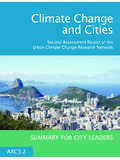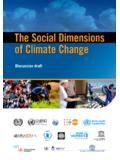Transcription of New York City Panel on Climate Change Climate Risk
1 The city of New YorkMayor Michael R. BloombergMayor s Office of Long-Term Planning & SustainabilityCity HallNew york , NY york city Panel on Climate ChangeClimate Risk Information 2013 Observations, Climate Change Projections, and MapsJUNE 2013 Printed on paper containing 30% post-consumer more information, please visit: Photo: Aerial View of Brooklyn and Staten Island Credit: Randy Plemel1 New york city Panel on Climate Change (NPCC2)Cynthia Rosenzweig (Co-Chair), NASA Goddard Institute for Space Studies and Columbia University, Earth InstituteWilliam Solecki (Co-Chair), Hunter College, city University of New york , CUNY Institute for Sustainable CitiesReginald Blake, New york city College of TechnologyMalcolm Bowman, Stony Brook UniversityVivien Gornitz, Columbia University, Earth InstituteKlaus Jacob, Columbia University, Lamont-Doherty Earth Observatory Patrick Kinney, Columbia University, Mailman School of Public HealthHoward Kunreuther, University of PennsylvaniaYochanan Kushnir, Columbia University, Lamont-Doherty Earth ObservatoryRobin Leichenko, Rutgers UniversityNing Lin, Princeton University Guy Nordenson, Princeton UniversityMichael Oppenheimer, Princeton UniversityGary Yohe, Wesleyan University NPCC2 Technical TeamRadley Horton (CCRUN Lead)
2 , Columbia University and Consortium for Climate Risk in the Urban Northeast (CCRUN)Lesley Patrick (CISC Lead), city University of New york , CUNY Institute for Sustainable Cities (CISC)Daniel Bader, Columbia University and CCRUNS omayya Ali, Columbia University and CCRUNC hristopher Little, Princeton UniversityPhilip Orton, Stevens Institute of Technology and CCRUNK risten Grady, city University of New york , CISCNew york city Mayor s Office of Long-Term Planning and Sustainability Leah Cohen, Senior Policy Advisor2 AcknowledgmentsThe New york city Panel on Climate Change (NPCC2) gratefully acknowledges the expert reviewers of the Climate Risk Information 2013 especially thank Daniel Bader, Somayya Ali, Gary Monitz, Richard Goldberg and Jos Mendoza from Columbia s Center for Climate Sys-tems Research (CCSR), Lesley Patrick from CUNY s Institute for Sustainable Cities (CISC), and Yonggang Liu from Princeton University for their great contributions to the creation of the NPCC2 projections and maps, as well as to this report.
3 We also thank, Leah Cohen, Carrie Grassi, Erika Lindsey, and Siena Chiang at the New york city Mayor s Office and other stakeholders from New york city whose inputs greatly improved the Climate risk information presented in the information in this document reflects the views and opinions of the New york city Panel on Climate Change and not the city of New Citation:New york city Panel on Climate Change , 2013: Climate Risk Information 2013: Observations, Climate Change Projections, and Maps. C. Rosenzweig and W. Solecki (Editors), NPCC2. Prepared for use by the city of New york Special Initiative on Rebuilding and Resiliancy, New york , New Executive SummaryClimate Change and New york CityUncertainty and Risk ManagementObserved ClimateMethods of Climate Projections Climate ProjectionsFuture Coastal Flood Risk MapsConclusions and RecommendationsSupplementary Information* Climate Observations and Projections: Methods and Analyses Sea Level Rise Observations and Projections: Methods and Analyses Future Coastal Flood Risk Maps.
4 Methods47911141824 New york city Panel on Climate ChangeClimate Risk Information 2013 Observations, Climate Change Projections, and Maps27*Supplementary Information sections of the CRI 2013 are available online at , , , and 11, 2013 version4 Climate Change poses significant risks to New york city s communities and infrastructure. Hurricane Sandy has focused attention on the ef-fects that extreme Climate events have on New york city , reminding New Yorkers that the city is vulnerable to a range of Climate hazards today and in the help respond to Climate Change in New york city and accomplish the goals outlined in PlaNYC, the city s long-term sustainability plan, Mayor Bloomberg convened the First New york city Panel on Climate Change (NPCC1) in 2008.
5 The NPCC a body of leading Climate and social sci-entists and risk management experts was charged with advising the Mayor and the New york city Climate Change Adaptation Task Force on issues related to Climate Change and adaptation. It produced a set of Climate projections specific to New york Hurricane Sandy, Mayor Bloomberg convened the second New york city Panel on Climate Change (NPCC2) in January 2013 to provide up-to-date scientific information and analyses on Climate risks for use in the Special Initiative for Rebuilding and Resiliency (SIRR). In response to the Mayor s charge to the Panel , this Report provides new Climate Change projections and future coastal flood risk maps for New york city .
6 This Climate risk information is designed to inform commu-nity rebuilding plans, and help to increase current and future resiliency of communities, and citywide systems and infrastructure to a range of Climate york city Temperature, Precipitation, and Sea Level Observed TrendsTrends in temperature, precipitation, and sea levels have increased overall throughout the century, but with interannual and decadal varia-tions. Mean annual temperature in New york city has increased F from 1900 to 2011. Mean annual precipitation has increased inches from 1900 to 2011 (a Change of percent per decade). Year-to-year precipitation variability was greater from 1956 to 2011 than from 1900 to 1955. Sea level in New york city (at the Battery) has risen feet since 1900.
7 It is not possible to attribute any single extreme event such as Hurricane Sandy to Climate Change . However, sea level rise occur-ring over time in the New york city area increased the extent and the magnitude of coastal flooding during the Climate Projections for New york City1,2By mid-century, temperatures are extremely likely3 to be higher in New york city . Global Climate models (GCMs) project that mean an-nual temperatures will increase. Specifically: By the 2020s, the middle range of projections is F to F and the high estimate is F By the 2050s, the middle range of projections is F to F and the high estimate is FTotal annual precipitation in New york city will likely increase by mid-century.
8 Mean annual precipitation increases as projected by GCMs are: By the 2020s, the middle range of projections is 0 percent to 10 percent, and the high estimate is 10 percent By the 2050s, the middle range of projections is 5 percent to 10 percent, and the high estimate is 15 percentHigher sea levels are extremely likely by mid-century. Projections for sea level rise in New york city are: By the 2020s, the middle range of projections is 4 to 8 inches, and the high estimate is 11 inches By the 2050s, the middle range of projections is 11 to 24 inches, and the high estimate is 31 inches By the 2050s, the NPCC projects the following changes in extreme events: Heat waves are very likely to become more frequent, more in-tense, and longer in duration Heavy downpours are very likely to increase in frequency, inten-sity, and duration Coastal flooding is very likely to increase in frequency, extent, and height as a result of increased sea levelsExecutive Summary1 Temperature and precipitation timeslices reflect a 30-year average centered around the given decade ( , the time period for the 2020s is from 2010-2039), and changes are expressed relative to the baseline period 1971 2000.
9 For sea level rise, the timeslice represents a 10-year average centered around the given decade ( , the time period for the 2020s is from 2020-2029), and changes are expressed relative to the 2000 2004 baseline. Projections rounded to the nearest half degree, five percent and Shown are the middle range (25th to 75th percentile) and high estimate (90th percentile) of the projections. 25th percentile = value at which 75 percent of the projections are higher; 75th percentile = value at which 25 percent of the projections are higher; 90th percentile = value at which 10 percent of the projections are higher. In the first New york city Panel on Climate Change (NPCC1) Climate Risk Information (Horton and Rosenzweig, 2010), the central range was defined as 17th to 83th Probability of occurrence and likelihood defined as (IPCC, 2007).
10 Virtually certain>99 % probability of occurrenceExtremely likely>95 % probability of occurrenceVery likely>90 % probability of occurrenceLikely>66 % probability of occurrenceMore likely than not>50 % probability of occurrenceAbout as likely as not33 to 66 % probability of occurrence5 Future Coastal Flood Risk MapsMaps that show future coastal flood risk (including areas affected by coastal storm surges combined with sea level rise), related vulner-ability, and potential impacts are important ways of communicating information to a wide variety of stakeholders and decision-makers. To estimate potential impacts of sea level rise on the spatial extent of the current 100- and 500-year flood zones, the NPCC2 developed a series of maps incorporating NPCC2 projections for sea level rise with FEMA s 2013 Preliminary Work Maps.
















